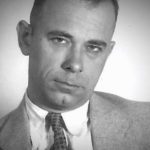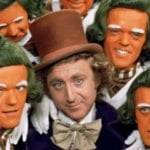 Music
Music  Music
Music  History
History 10 Less Than Jolly Events That Occurred on December 25
 Weird Stuff
Weird Stuff 10 Funny Ways That Researchers Overthink Christmas
 Politics
Politics 10 Political Scandals That Sent Crowds Into the Streets
 Weird Stuff
Weird Stuff Ten Bizarre Facts About The Doge Meme
 Our World
Our World 10 Ways Your Christmas Tree Is More Lit Than You Think
 Movies and TV
Movies and TV The 10 Coolest Stars to Set Sail on The Love Boat
 History
History 10 Things You Didn’t Know About the American National Anthem
 Technology
Technology Top 10 Everyday Tech Buzzwords That Hide a Darker Past
 Humans
Humans 10 Everyday Human Behaviors That Are Actually Survival Instincts
 Music
Music 10 Surprising Origin Stories of Your Favorite Holiday Songs
 History
History 10 Less Than Jolly Events That Occurred on December 25
 Weird Stuff
Weird Stuff 10 Funny Ways That Researchers Overthink Christmas
Who's Behind Listverse?

Jamie Frater
Head Editor
Jamie founded Listverse due to an insatiable desire to share fascinating, obscure, and bizarre facts. He has been a guest speaker on numerous national radio and television stations and is a five time published author.
More About Us Politics
Politics 10 Political Scandals That Sent Crowds Into the Streets
 Weird Stuff
Weird Stuff Ten Bizarre Facts About The Doge Meme
 Our World
Our World 10 Ways Your Christmas Tree Is More Lit Than You Think
 Movies and TV
Movies and TV The 10 Coolest Stars to Set Sail on The Love Boat
 History
History 10 Things You Didn’t Know About the American National Anthem
 Technology
Technology Top 10 Everyday Tech Buzzwords That Hide a Darker Past
 Humans
Humans 10 Everyday Human Behaviors That Are Actually Survival Instincts
10 Real-Life Heroes Who Became Villains
In life, there are heroes and villains. Then some were villains, who later found themselves on the winning side, and history painted them heroes by default. And finally, there are those who rose to the top of philanthropic stardom, invented a life-saving cure, or defeated an entire fascist movement by showing up, doing more than expected, and getting the results. People in society need heroes to bear their flag and fight the good fight. So it is no wonder those who stray from the path fall from those high perches and fall hard. Here are ten heroes who lived long enough to become the villain.
Related: 10 Heroes Who Lived To See Themselves Become The Villains
10 Henry Heimlich
Henry was an American thoracic surgeon and researcher credited with inventing a move meant to save people from choking—the Heimlich maneuver. Many of us have experienced the sensation of choking, yet not many know that in 2020, more than 4,900 people died from choking in the U.S. alone. That is a staggering amount of deaths, and one could only imagine what the numbers would look like had Henry not invented the Heimlich. It is, therefore, safe to say that Henry is directly responsible for saving thousands (if not millions) of lives around the world from turning smurf blue from unchewed steak.
However, his legacy turned sour when it became evident that his promoted use of the maneuver to assist drowning victims had destructive results. He also advocated for the use of malaria therapy to treat HIV. His controversial nature became so problematic that they even took the name of his own move from him, now calling it an abdominal thrust rather than a Heimlich. What a way to choke, Henry.[1]
9 Philippe Petain
Henri Philippe Benoni Omer Petain, commonly known as Marshal Petain, was a French general who attained the position of Marshal of France during WW1. Amid the horrors of the war, he was credited for stopping the Germans at the Battle of Verdun and was given the killer nickname, the Lion of Verdun, for his exploits. A literal war hero for the French army, Petain turned villain faster than he could lift his arm in a Nazi salute when he became chief of state after Germany’s invasion in 1940.
In his pursuit of making France great again, he collaborated with the Nazi regime and adopted repressive measures against the Jewish populace. He was later sentenced to death, which was reduced to life imprisonment.[2]
8 Jim Jones
In the earlier days of Jim Jones, he was known as a charismatic churchgoer with powers of healing and foresight. Not an uncommon personality for the time, yet Jones’s religious antics could be forgiven on the basis that he made waves fighting racial integration (which at the time did not go down well with the church elders) and established organizations that would help combat homelessness. Admirable qualities that nobody could fault, regardless of religion or creed.
It should have ended there, but Jones developed what some might call narcissistic personality disorder. Along with a strong contingent of followers, Jones established the Peoples Temple Agricultural Project—Jonestown—in Guyana. It became the home of the U.S.-based cult that Jones formed. Long story short, his whole congregation drank cyanide-laced kool-aid. Jones is therefore considered to be the cause of one of the largest religious mass suicide in the history of this world, killing 913 people (304 under the age of 18). Worst of all, he didn’t even drink his own poison.[3]
7 Benedict Arnold
An American military officer who served in the Revolutionary War, he was hailed as a hero for his efforts. He fought with distinction for the American Continental Army and rose all the way to the rank of major general before defecting to the British side of the conflict and choosing the title of most hated man, possibly in the history of America.
Many theories have come about as to why Arnold became a defector: greed, debt, resentment of other officers, hatred for the Continental Congress, and even a desire for the colonies to remain under British rule. Yet financial woes seemed to be his main driver. Arnold allegedly avoided the gallows and fled to Britain after the war had concluded, where he lived out his life as an unsuccessful businessman/traitor. In pop culture, the words “Benedict Arnold” became synonymous with treason or becoming a traitor.[4]
6 Richard Jewell (or, Rather, the Media)
Let’s clear something up first. Richard was not the villain, he was exonerated and cleared, yet his reputation had taken the blow nonetheless. This is more about the media becoming the villain than Richard being suspected of terrorism. At the 1996 Summer Olympics in Atlanta, Richard discovered a suspicious-looking bag containing homemade explosive devices rigged to blow. After the discovery, Jewel was able to get attendees away from the danger zone; however, the blast still managed to kill one person and injure 111 others.
In a move that saved countless lives, Richard was hailed as a hero until a list of FBI suspects leaked, painting Richard as a suspect. The media turned sour quicker than milk left in the sun, as they lambasted him for his possible role in the bombings, even shaming his weight and overall appearance. In the end, Jewel was cleared. After multiple libel lawsuits and a few legal settlements, Jewel served in several police jobs before passing away due to health complications. From hero to villain to not villain.[5]
5 Harry Harlow
In the early 20th century, many psychologists believed that showing affection toward children was merely a sentimental gesture rather than an essential developmental component. Harry Harlow set out to study the topic that wasn’t easy to quantify and measure—love. Harry performed tests in a series of controversial experiments using rhesus monkeys to show the effects of love and its absence. His work demonstrated the devastating result of social deprivation on young monkeys and revealed the importance of a caregiver’s love for childhood development.
Unethical already, it should have ended there. After his wife passed away from cancer, Harry doubled down on the villainous side of things. He began experimenting with punishment and reward before also creating things like the wire mother experiment, cages built to induce depression, tunnel of terror, and the pit of despair. Each is uniquely inhumane in its own way. Eventually, the ethics committee caught up and put a stop to his antics.[6]
4 Linus Pauling
For a man who won Nobel prizes for chemistry and peace and published over a thousand papers and books dealing with an array of scientific topics, Linus was on a speedboat to become one of the most highly regarded scientific minds of his generation. Linus did a lot of work in studying Vitamin C and the positive effects it could have on the body, making such claims that it can cure cancer, which the medical fraternity shot down with scorn.
Instead of taking the criticism on the chin, he directed all his energy to prove those who disagreed with him wrong. This endeavor proved to be a bridge too far, as it turned out he was, in fact, wrong. It wasn’t that he was an evil man per se, but rather that his insistence on being right caused a ripple effect that could be seen even today among those who seem to consume vitamins like Tic-Tacs thinking that they might reap the benefits.[7]
3 Fritz Haber
If Fritz Haber was a superhero, he would be called the “Two-sided Coin,” as he had one of the most “good guy, bad guy” lives in all of history. But actually, Haber was nothing more than an exceptional chemist. One of the most well-known chemists ever, responsible for the Haber-Bosch process, an important method for large-scale synthesis of fertilizers and explosives. It was also this work that won him the Nobel prize in chemistry.
The problem, however, was that he was one of the best in the business when the Germans declared war against the world, and as history would paint them, they were the bad guys. After Haber joined the German army and was promoted to the rank of Captain and head of the Chemistry Section in the Ministry of War, he developed the first chemical weapons used in WW1. Ultimately, Haber ushered in an era of chemical warfare that, to this day, is as tragic and horrific as the first time it was implemented.[8]
2 Charles Lindbergh
Charles Lindbergh is known in history as the first airline pilot to fly solo across the Atlantic, making the long trip from New York to Paris in one non-stop flight on May 20-21, 1927. It made him an instant hero in a society obsessed with feats of accomplishment and bravado. Just before the war, however, he was awarded medals from the Nazi government, which started the slide. When WW2 broke out, it polarized not only the countries involved in the war but also the populace of those who had not yet engaged.
Before the U.S. joined the fighting, a few figures made it known that they were opposed to the idea of the U.S. getting involved in foreign policy and conflicts of such scale. Lindbergh, in a famous anti-Semitic speech, went on to say that three groups were pushing the U.S. to join the war: (1) the British, (2) Roosevelt’s administration, and (3) the Jews. He added that the Jews would be better served to not join the war as they might feel its consequences the most. Labeled a Nazi sympathizer, he was never able to outlive the tarnish.[9]
1 Charles Romley Alder Wright
Charles was responsible for creating the most famous chemical found on the streets that make people go to Candy Mountain and was the original founder of the Royal Institute of Chemistry. Wright was a physics and chemistry researcher in London when he started experimenting with morphine, combining it with various acids. Being the good guy he was, he hoped to discover a nonaddictive (haha) alternative to the medicine.
Unfortunately, he soon stumbled upon an even more potent morphine by boiling a few fancy chemicals, thereby forming diacetylmorphine, or in modern language, heroin. The drug was marketed as a cough medicine until its addictive qualities were better understood before being removed from the market. To this day, it is known as one of the most addictive and destructive drugs out there. Thanks, Charlie.[10]








